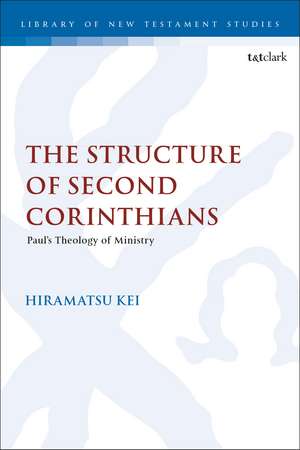The Structure of Second Corinthians: Paul’s Theology of Ministry: The Library of New Testament Studies
Autor Dr Kei Hiramatsuen Limba Engleză Hardback – 4 oct 2023
Din seria The Library of New Testament Studies
- 34%
 Preț: 509.52 lei
Preț: 509.52 lei - 22%
 Preț: 832.58 lei
Preț: 832.58 lei - 22%
 Preț: 832.09 lei
Preț: 832.09 lei - 24%
 Preț: 190.33 lei
Preț: 190.33 lei - 22%
 Preț: 832.65 lei
Preț: 832.65 lei - 23%
 Preț: 191.31 lei
Preț: 191.31 lei -
 Preț: 221.70 lei
Preț: 221.70 lei -
 Preț: 98.92 lei
Preț: 98.92 lei - 31%
 Preț: 830.87 lei
Preț: 830.87 lei - 22%
 Preț: 834.60 lei
Preț: 834.60 lei - 22%
 Preț: 831.59 lei
Preț: 831.59 lei - 30%
 Preț: 717.05 lei
Preț: 717.05 lei - 22%
 Preț: 835.03 lei
Preț: 835.03 lei - 30%
 Preț: 511.40 lei
Preț: 511.40 lei - 24%
 Preț: 190.33 lei
Preț: 190.33 lei -
 Preț: 158.77 lei
Preț: 158.77 lei - 30%
 Preț: 510.04 lei
Preț: 510.04 lei - 22%
 Preț: 832.99 lei
Preț: 832.99 lei - 30%
 Preț: 509.52 lei
Preț: 509.52 lei - 22%
 Preț: 832.80 lei
Preț: 832.80 lei - 22%
 Preț: 831.76 lei
Preț: 831.76 lei - 22%
 Preț: 834.93 lei
Preț: 834.93 lei - 22%
 Preț: 831.59 lei
Preț: 831.59 lei - 22%
 Preț: 832.41 lei
Preț: 832.41 lei - 22%
 Preț: 832.99 lei
Preț: 832.99 lei -
 Preț: 414.71 lei
Preț: 414.71 lei - 30%
 Preț: 773.65 lei
Preț: 773.65 lei - 22%
 Preț: 834.93 lei
Preț: 834.93 lei - 14%
 Preț: 511.81 lei
Preț: 511.81 lei -
 Preț: 222.16 lei
Preț: 222.16 lei - 30%
 Preț: 775.67 lei
Preț: 775.67 lei - 30%
 Preț: 1012.49 lei
Preț: 1012.49 lei - 30%
 Preț: 509.02 lei
Preț: 509.02 lei - 30%
 Preț: 656.90 lei
Preț: 656.90 lei -
 Preț: 469.92 lei
Preț: 469.92 lei -
 Preț: 471.68 lei
Preț: 471.68 lei -
 Preț: 173.21 lei
Preț: 173.21 lei - 30%
 Preț: 833.64 lei
Preț: 833.64 lei - 22%
 Preț: 834.93 lei
Preț: 834.93 lei - 31%
 Preț: 772.17 lei
Preț: 772.17 lei - 30%
 Preț: 774.20 lei
Preț: 774.20 lei - 14%
 Preț: 1124.92 lei
Preț: 1124.92 lei - 22%
 Preț: 948.51 lei
Preț: 948.51 lei - 14%
 Preț: 1128.84 lei
Preț: 1128.84 lei - 31%
 Preț: 1065.91 lei
Preț: 1065.91 lei - 22%
 Preț: 777.71 lei
Preț: 777.71 lei - 31%
 Preț: 1064.84 lei
Preț: 1064.84 lei - 22%
 Preț: 1063.44 lei
Preț: 1063.44 lei - 22%
 Preț: 889.49 lei
Preț: 889.49 lei - 22%
 Preț: 1006.06 lei
Preț: 1006.06 lei
Preț: 511.07 lei
Preț vechi: 731.59 lei
-30% Nou
Puncte Express: 767
Preț estimativ în valută:
97.80€ • 101.53$ • 81.55£
97.80€ • 101.53$ • 81.55£
Carte tipărită la comandă
Livrare economică 22 martie-05 aprilie
Preluare comenzi: 021 569.72.76
Specificații
ISBN-13: 9780567708847
ISBN-10: 0567708845
Pagini: 264
Dimensiuni: 156 x 234 mm
Greutate: 0.54 kg
Editura: Bloomsbury Publishing
Colecția T&T Clark
Seria The Library of New Testament Studies
Locul publicării:London, United Kingdom
ISBN-10: 0567708845
Pagini: 264
Dimensiuni: 156 x 234 mm
Greutate: 0.54 kg
Editura: Bloomsbury Publishing
Colecția T&T Clark
Seria The Library of New Testament Studies
Locul publicării:London, United Kingdom
Caracteristici
Demonstrates an inductive and integrated approach as a well-established and improved methodology for biblical exegesis
Notă biografică
Hiramatsu Kei is New Testament Faculty at Central Bible College, Japan. He has presented and published articles on Pauline letters, especially on the Corinthian Correspondence. He is the first Langham Scholar from Japan.
Cuprins
List of Illustrations Foreword by Chris Tilling Acknowledgments Abbreviations1. Introduction to Inductive Bible Study2. Survey of the Literary Structure and the Central Theme of 2 Corinthians 3. Salutation (1:1-2) and Closing (13:11-13)4. Arguments Pertaining to Basis for Ministry: Character of Ministry (1:3-2:13)5. Arguments Pertaining to Content of Ministry: Thesis Statement (2:14-17) 6. Arguments Pertaining to Content of Ministry: Proclamation of the Gospel (3:1-7:16) 7. Arguments Pertaining to Content of Ministry: Response 8. Arguments Pertaining to Content of Ministry: Defense Conclusion Bibliography
Recenzii
Reading 2 Corinthians is no easy task. What is the shape of Paul's argument? What can account for the major structural developments in the text? Turning to scholarship for answers is a bewildering experience as there are as many solutions to these questions as there are scholars of 2 Corinthians. Of course, the various partition theories, chronologies of Paul and his letters, and historical-critical reading strategies complicate matters further. What is needed is an integrated approach that doesn't lose sight of the wood for the trees, one that is conversant with the major scholarly issues and can advance a thesis with methodological clarity. Thankfully, into these choppy waters now wades Kei Hiramatsu with a set of elegant and sophisticated proposals to account for the shape of 2 Corinthians as a whole. He is conversant with the insights of topical, epistolary, rhetorical, literary, and discourse analytical findings, but moves beyond them all by employing an inductive and integrated methodology. The result is a compelling account of the major structural relations of the letter as a whole, both in broad sweep and in detail. Hiramatsu's structural analysis and methodology also offer him opportunity to present fresh perspectives on the theology of 2 Corinthians. It is, therefore, a delight that this learned and important work is now available to the wider academic community. Simply put, any future scholarly engagement with 2 Corinthians will need to tackle Hiramatsu's scholarship.
